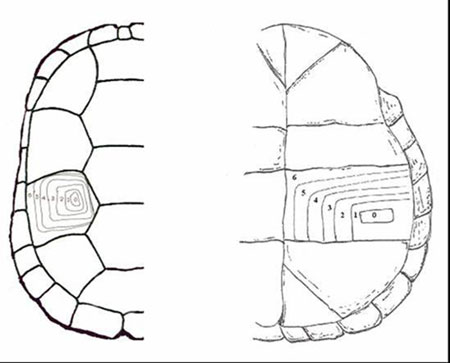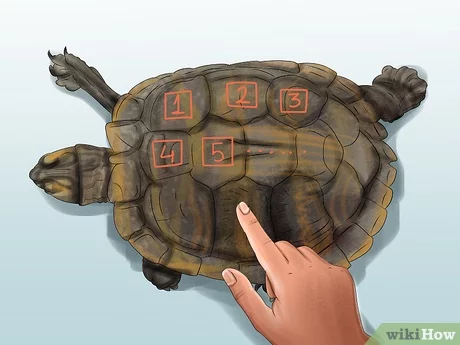To tell the age of a box turtle, you can count the growth rings on its shell, known as scutes. Each scute represents a year of growth, allowing you to estimate the turtle’s age.
Box turtles are fascinating creatures that can live for several decades, and determining their age can provide valuable insights into their life history. By understanding the methods for determining a box turtle’s age, you can gain a deeper appreciation for these remarkable reptiles.
We will explore the different techniques and indicators that can help you estimate a box turtle’s age accurately. Whether you are a turtle enthusiast, a wildlife researcher, or simply curious about these intriguing animals, learning how to determine a box turtle’s age can enhance your understanding and appreciation of these incredible creatures. So, let’s dive into the fascinating world of box turtle age determination and uncover the secrets hidden within their shells.

Credit: www.youtube.com
Box Turtle Physical Characteristics
Box turtles can offer clues to their age through their physical characteristics.
Let’s explore the features that can help determine a box turtle’s age.
Shell
The shell of a box turtle can indicate its age through growth rings visible on the scutes.
Counting the rings can provide an estimate of the turtle’s age.
Claws
The length and condition of a box turtle’s claws can also give insights into its age.
Older turtles tend to have longer and more worn-down claws.
Skin
The texture and color of a box turtle’s skin may change as it ages.
Younger turtles typically have smoother and brighter skin compared to older ones.
Eyes
Observing the clarity and brightness of a box turtle’s eyes can help estimate its age.
Older turtles may have cloudier or duller eyes than younger ones.

Credit: m.youtube.com
Age Determining Factors
Growth Rings On Shell
Box turtles, like many other species, have growth rings on their shells that can provide valuable information about their age. These growth rings, also known as annuli, are visible on the scutes of the turtle’s shell. By counting the number of growth rings, you can estimate the turtle’s age. However, this method may not always be accurate, as environmental factors and the turtle’s health can affect the growth rate and appearance of the rings.
Size And Weight
The size and weight of a box turtle can also be indicators of its age. As turtles age, they tend to grow larger and heavier. By comparing the size and weight of a turtle to typical measurements for its species, you can make an educated guess about its age. However, this method is not entirely precise, as individual variations and environmental factors can influence a turtle’s growth rate.
Coloration
The coloration of a box turtle’s shell and skin can offer some clues about its age. Younger turtles often have brighter and more vibrant colors, while older turtles may display faded or worn-out hues. Additionally, the presence of darker pigmentation or patterns on the shell can indicate that the turtle has reached a certain age. However, it’s important to note that coloration can also be influenced by factors such as diet, habitat, and overall health.
Methods For Age Estimation
Box turtles are fascinating creatures, and determining their age can provide valuable insights into their life cycle. There are several methods for estimating the age of a box turtle, each offering unique clues about the turtle’s history and growth.
Counting Growth Rings
This method involves counting the growth rings on a box turtle’s scutes, which are the bony plates on their shell. Each ring represents a year of growth, similar to tree rings.
Measuring Size And Weight
Another way to estimate a box turtle’s age is by measuring its size and weight. Younger turtles are generally smaller and lighter, while older turtles tend to be larger and heavier.
Observing Coloration
The coloration of a box turtle’s shell and skin can also provide clues about its age. Young turtles often have brighter and more vibrant colors, while older turtles may have faded or worn-out hues.
Examining Scutes
Examining the condition of a box turtle’s scutes can help determine its age. Young turtles have smooth and unblemished scutes, whereas older turtles may have worn or damaged scutes.

Credit: boxturtle.uncg.edu
Limitations Of Age Estimation Methods
When trying to determine the age of a box turtle, it is important to be aware of the limitations of age estimation methods. While various techniques can provide valuable insights, they also have their drawbacks. Understanding these limitations is essential for accurate age assessment.
Inaccuracy Of Growth Ring Counting
Counting growth rings on the scutes of a box turtle’s shell is a commonly used method for estimating age. However, this approach has limitations as the rings may not always form annually, leading to inaccuracies in age determination.
Variability In Size And Weight
Assessing a box turtle’s age based on its size and weight can be challenging due to the considerable variability within the species. While larger turtles are generally older, individual growth rates and environmental factors can lead to discrepancies in age estimation.
Coloration Changes Over Time
Monitoring changes in a box turtle’s coloration is another method for estimating age. Over time, the pigmentation and patterns on their shells may evolve, but this approach is not entirely reliable as the changes can be influenced by factors other than age.
Scute Wear And Tear
Examining the wear and tear on a box turtle’s scutes is a way to gauge its age, but this method also has limitations. Environmental factors and individual behaviors can impact scute condition, affecting the accuracy of age estimation through this approach.
Conclusion
Determining a box turtle’s age can be challenging but observing shell patterns and size helps. Remember, age estimation is an approximation, not an exact science. By closely examining these features, you can make an educated guess about the age of a box turtle.
Understanding their age adds to our appreciation of these fascinating creatures.






Leave a Reply